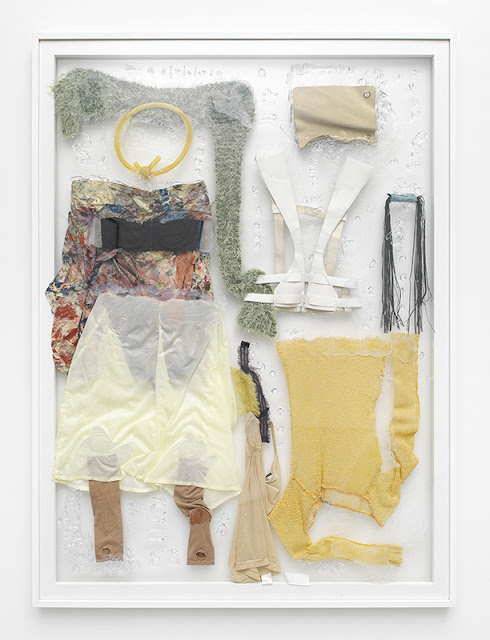DONNA HUANCA: ECHO IMPLANT
 |
Crush Part 2, 2015. Clothing, leather, silicone, Plexiglas, wood frame; 70 x 51 x 2 inches
|
Three years ago,
on a cold rainy winter day, I chanced
upon a closing party for Donna Huanca, to whom I was quickly introduced. As we
exchanged pleasantries I glanced around the gallery, which was hung to the rafters
with the various details of her work. There were entire outfits of clothing
pressed between panes of glass and framed; vaguely biomorphic masses that
resembles torsos as tree stumps or compost cubes; mostly nude models with their
bodies painted standing like statues on a balcony above or upon a shelf or
pedestal upon the wall, staring blankly over the crowd; clearly Huanca desired
to bridge the gap between introspection and spectacle.
I recall the space
of the Joe Sheftel Gallery. Tall and narrow, it gave the impression of being a
marginal space, like a stage with the curtain down, after hours, or a forgotten
alleyway. The way that Huanca’s work inhabits the space further deconstructs
the decorum that usually invests gallery exhibitions. It’s as if we have exited
a formal space and have entered one narrating the precincts of her
consciousness. I recall being at first very taken by the objectness in her
work--her regard for the innate presence of any object associated with the
body, or in some way representing a body, giving presence through sensuality.
These manifestations have to be described to be given justice.
 |
Screiii, 2015. Platex,
velvet, nylon, and metal; 58 x 30 x 22 inches
|
The more I look at
images from the exhibition, the more that I understand that Huanca views
herself as an arranger of space rather than a maker of objects--a generator of
dynamically charged arrangements that sometimes offer a degree of performance.
There does not have to be much motion involved, for naked bodies in themselves
are inherently dramatic, even when perfectly still. We learned this from
Vanessa Beecroft in the Nineties. However there is a world of difference
between erotism and action. Anyone can be emboldened by desire, and anyone can
use it. It is the specific usage to which Huanca puts these bodies—to energize
a visual language about the use of space—that matters.
 |
KZ2009, 2015. Plaster and
latex paint on canvas; 60 x 48 x 1 ¾ inches
|
Huanca’s work
revolves around the body, presuming some interest in performance but delivering
a hybrid between narrative and static symbolism. To be sure, there are
performances scattered among her installations, for after all, how long could
the spectator be expected to merely stare at bodies without expecting them to
move, to do something human? “Echo Implant” was a loaded set that provided
further cues for the curious on the nature of bodies.
 |
Bukket, 2015. Ceramic,
fabric, wood, Plexiglas; 54 x 18 x 18 inches
|
My experience of
the show was different from other exhibitions at galleries in one regard.
Though I had peered around the installation and must have seen the bodies of
her human mannequins, I was not completely aware of them as actual bodies. Not
as skin, muscle, sweat, chill, nipple. Once I had it transformed my experience
of the exhibition, altering my degree of emotional distance, my intellectual
engagement with the other objects was pushed into a subconscious corner while I
stared up at these mute players standing listlessly on plinths. All the other
art works, which referenced a body, or the absence of one, could have easily
come off of these specific bodies. The exhibition as a whole began to make
sense, to become less amorphous, and to relate not only a language of the body
as implied, but as a body palpable and evident. I felt the strength of Huanca’s
vision. Here was not merely a gallery as an isolated space, one of many small
rooms along a street of similar spaces, like a shop in a Parisian Arcade, but a
room like a stage where the proscenium is everywhere, especially on the edge of
the subconscious mind of its occupants, who becomes instant players. The
aesthetic experience is made complete by bringing art objects as suggestive artifacts
into the territory of the actual body. They clothe it without intention.
 |
Gala Tears, 2015.
Clothing in Plexiglas with metal frame; 48 ½ x 36 ½ x 1 ¾ inches
|
In the art world
we are conditioned to see everything as a construct, and to organize complex
systems of reasoning around such constructs. Yet the presence of something real
and human pulls us from our perch in the cerebral and thrusts us back into the
visceral. Suddenly we are reacting instinctually. We begin to distrust our
reactions, and to distrust the reasoning, and its related assumptions, behind
these reactions, which fall farther and farther from something meaningful in an
intimate fashion. Huanca puts us on equal footing with our shared humanity.


Comments